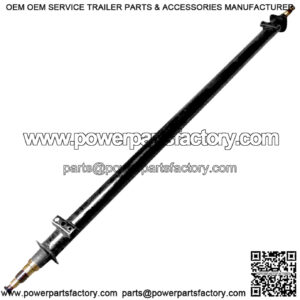Single-Axle and Dual-Axle Similarities
Both a single and tandem-axle trailer can transport a wide range of cargo within their weight limits. You can choose between open or enclosed solutions with both configurations, too. Aside from a few other similarities like required maintenance and customizability, both trailer types require special attention to braking.
Hauling a trailer of any size increases the stopping distance of your entire rig. Once you attach a trailer to your truck, SUV or another vehicle, you need more time and distance to come to a complete halt. Braking with added weight behind you also wears out your vehicle’s brakes faster.
Talk to a professional to figure out what kind of brakes may work best for your trailer size and driving experience.
Single-Axle and Dual-Axle Differences
Single- and dual-axle units have the same purpose: hauling cargo safely. However, the differences are what you want to focus on when deciding which matches your expectations. Three main differences to examine include the gross combined weight rating, the tongue weight and the hitches.
1. Gross Combined Weight Rating
Weight is an important variable when considering trailer types. In addition to a trailer’s payload capacity, you should consider your setup’s gross combined weight rating (GCWR). This term refers to the total combined weight your setup can handle safely.
To calculate a potential GCWR, add the following values:
- The weight of your towing vehicle
- The weight of any vehicle occupants or luggage
- The weight of the loaded trailer
You can check your calculated GCWR against the number given by your vehicle manufacturer to ensure you are within a safe range. The GCWR of a single-axle trailer will be less than a heavy-duty tandem-axle. Staying within your GCWR can help make sure your towing and braking are effective and safe.
2. Tongue Weight
When comparing the two configurations, you’ll also want to consider tongue weight. Tongue weight describes how much of the load is on the hitch. Between 5% and 15% of the trailer weight should rest on the hitch. If you undershoot this weight, the joint may sway more than usual. If there’s too much pressure on the hitch, steering may become more difficult.
Calculating your tongue weight may look different depending on whether you have a single- or dual-axle trailer. For example, you may be able to prop a standard bathroom scale on a cinder block to measure the tongue weight on a single-axle rig. You may need to purchase a specific tongue weight scale to measure the weight on a dual-axle trailer.
3. Hitches
Single- and dual-axle configurations require properly sized hitch balls. The size of the trailer corresponds to the size of the ball — so a more compact rig will need a smaller hitch, and a larger trailer will need one that matches its size. An ill-fitting hitch ball could cause your trailer to detach while driving.
About trailer axle
“trailer axle kit”
“trailer axle for sale”
“trailer axle parts”
“boat trailer axle”
“3500 lb trailer axle”


